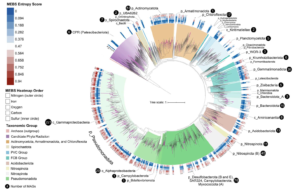Metabolic capacity is maintained despite shifts in microbial diversity in estuary sediments
Estuaries are highly productive ecosystems where microbial communities drive nutrient and carbon cycling, supporting complex food webs. With intensifying anthropogenic pressures, it is critical to understand the capacity of these communities to maintain essential functions under environmental change. Here, we examined the metabolic functions and redundancy in the microbial community of San Francisco Bay (SFB) sediments, providing the first large-scale, genome-resolved, and spatiotemporally resolved characterization of the estuary. Salinity, iron, phosphorus, sulfur, and total sediment nitrogen were significantly correlated with microbial community composition, suggesting these factors play a key role in structuring SFB communities. In support of this, we identified broad capabilities for iron cycling and key uncultured players that contribute to denitrification, nitrification, and complete nitrification (comammox). We also identified widespread capabilities for sulfur cycling, including understudied lineages capable of rDsr-mediated sulfur oxidation. SFB MAGs exhibited partitioning of multi-step metabolisms, or metabolic handoffs, and the rare biosphere broadly encoded key nitrogen and sulfur cycling genes. Despite shifts in community composition across sites and fluctuations in environmental parameters, key nitrogen and sulfur metabolisms were maintained throughout the estuary, especially in nitrate reduction, nitrite reduction, and the Dsr/Sox pathway. The presence of multiple microbial taxa with similar functional roles (functional redundancy) may provide an ecosystem buffer, suggesting these functions could better recover from disturbances and ultimately contribute to the long-term health and sustainability of these vital coastal habitats.

